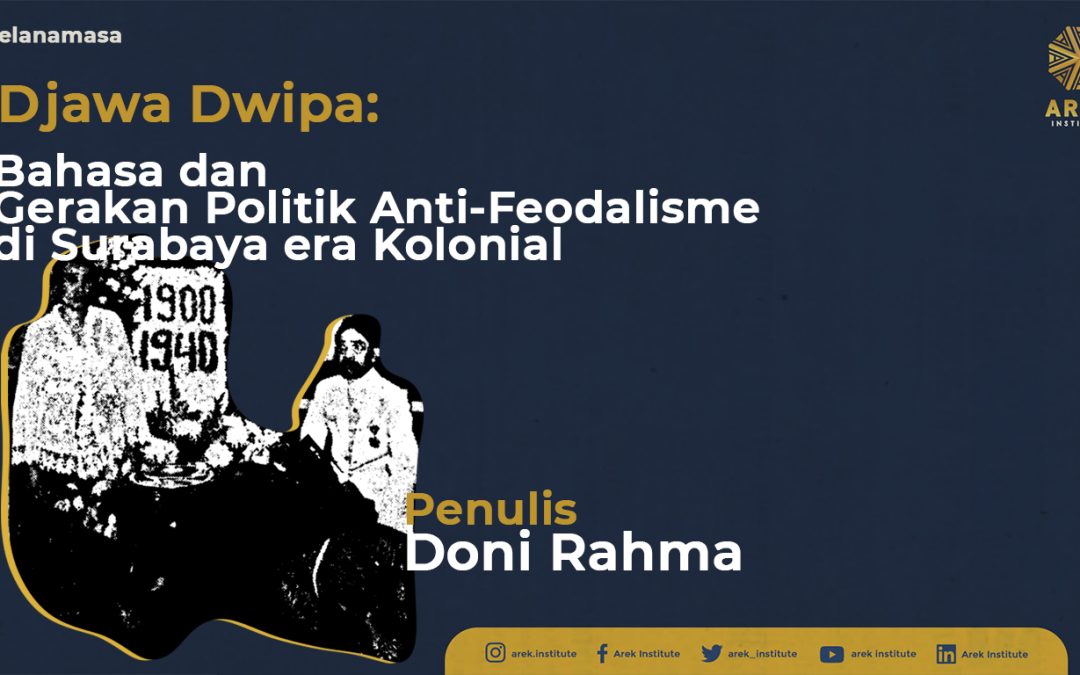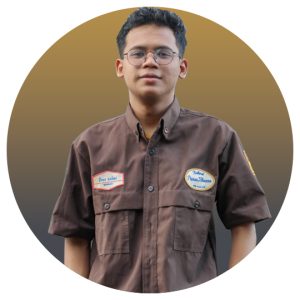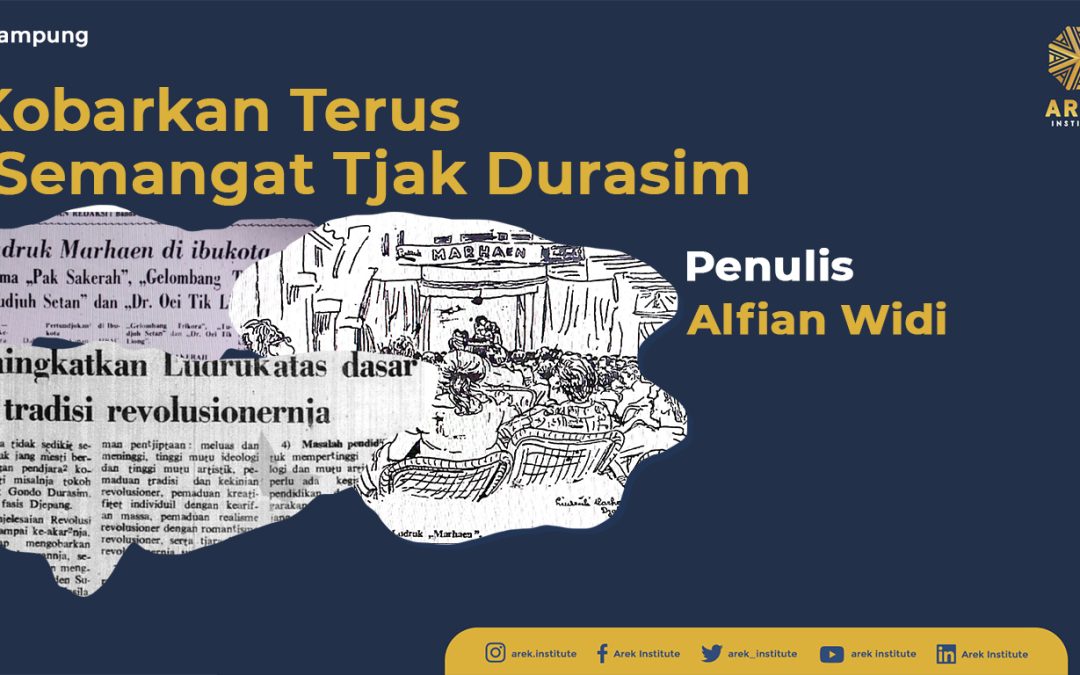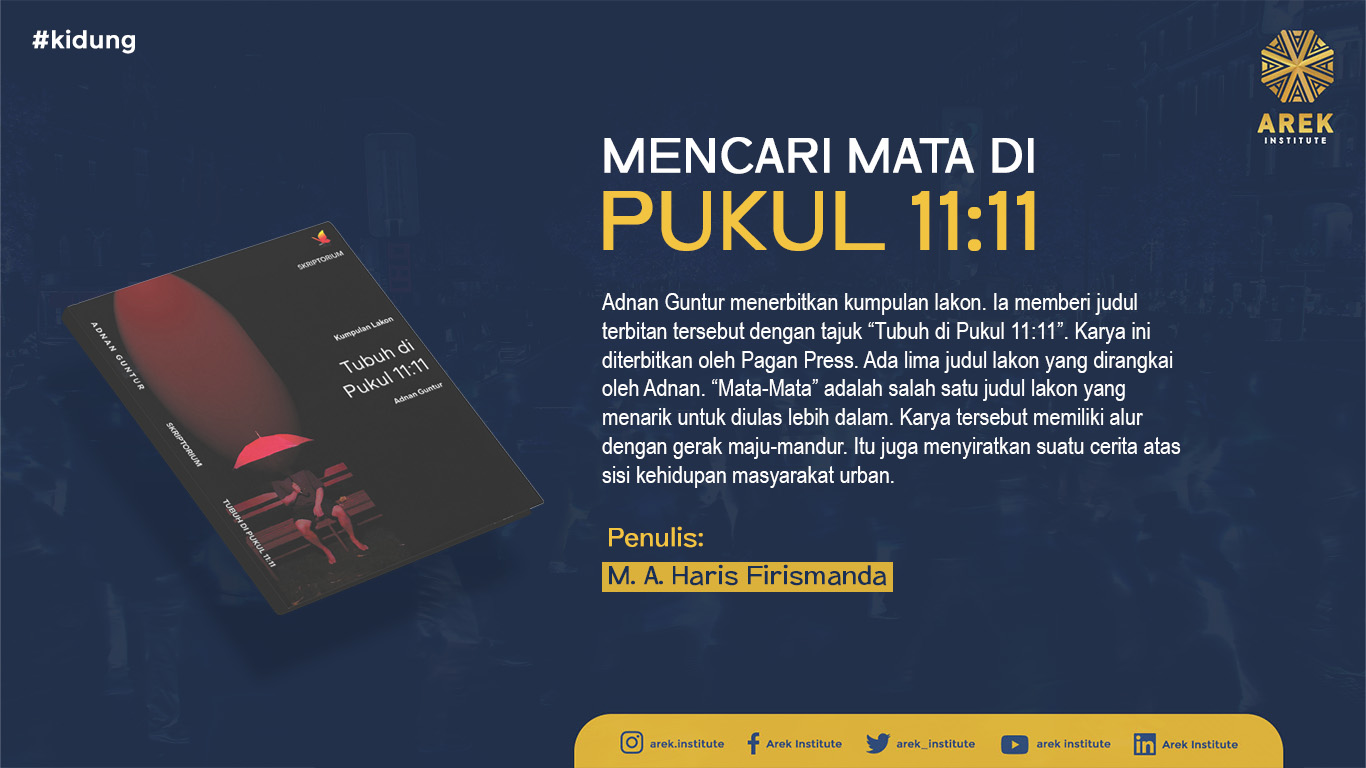
by Penelitian Arek | Sep 4, 2025 | Kelana Masa

Doni Rahma | Anthropology FISIP Unair Student | Arek Institute Researcher Network
Almost 100 years ago, on March 11, 1917, in Surabaya, a movement called Djawa Dipa was born, opposing the feudalistic practices of the time. According to various records, the movement was first initiated in two locations: the Oost Java Bioscoop building (now a shopping complex in the Aloon-aloon Contong area) and the Oost JavaRestaurant. From its inception, Djawa Dipa aimed to equalize the use of the Javanese language by abolishing its hierarchical structure. In other words, unggah-ungguhing basa (the stratified levels of Javanese language such as ngokoand krama) had to be eliminated. The Krama class, referring to the lower layers of Javanese society, became the movement’s main focus because equality for them was of utmost importance. Until then, the hierarchy in the use of the Javanese language had only widened the gap of social stratification and reinforced unfair treatment against them (Thamrin, 2022).
One of the key figures behind the birth of Djawa Dipa was Tjokrosoedarmo, the leader of the SI (Sarekat Islam) Surabaya branch — a native arek Suroboyo from the Plampitan neighborhood, who came from a priyayi (noble) family background. However, in contrast to his aristocratic origins, he became a vocal critic of the rules governing the use of krama (high-level Javanese language). For him, a language structure built on rigid hierarchy was not a tool for communication, but rather a wall of oppression — something that burdened the Javanese people. This was evident in a fragment of his radical ideas, delivered during a speech at the formation of the Djawa Dipa committee, which was also published in the Sinar Djawa newspaper, March 15, 1917 edition.
”…telah njata kita ketahoei, sampai saat ini, dan sampai zaman perobahan ini, atoeran bahasa Djawa ”kromo” itoe hanjalah membikin soesah kita Djawa sadja. Berlantaran atoeran bahasa Djawa ”Kromo” itoe tidak sedikit bilangannya…Maka ketjelakaan dan kesengsaraan pendjara itoe bagi kita boekan bangsa ”sastrawan” hanjalah lantaran soesahnja atoeran bahasa Djawa ”kromo” ada di moeka persidangan hakim”
(…it is clear to us, even up to this moment, and into this era of change, that the rules of the Javanese ‘krama’ language only bring hardship to us Javanese. Because of these ‘krama’ language rules—of which there are no small number… Misfortune and the suffering of imprisonment for us, who are not a ‘literary’ people, are merely caused by the difficulty of these ‘krama’ rules when faced in front of the judge’s court.)
In its time, Djawa Dipa appeared to be supported by prominent figures, including Tjokroaminoto of Sarekat Islam itself. Although Tjokroaminoto was initially not very enthusiastic about the emergence of Djawa Dipa, as the movement gradually expanded in 1918 and his dominance within Sarekat Islam (CSI) began to wane, he quickly moved to consolidate new forces. Djawa Dipa was then promoted and pushed to become a militant movement aimed at transforming the “slave mentality” of the Javanese people (Siraishi, 1997).
As a movement, Djawa Dipa often directly issued appeals encouraging the reduction of krama (high-level Javanese) usage. One of its early recommendations included changing honorifics or forms of address: using “Wiro” for men, “Woro” for married women, and “Liro” for unmarried women (Thamrin, 2022). The movement also expanded to include calls for rejecting long-standing gestures of deference embedded within the Dutch East Indies bureaucracy. These gestures included a wide range of social behaviors, dress codes, hierarchical language use, and honorary titles.
Javanese people were required to treat Dutch officials with elaborate forms of submission: walking in a crouched or squatting position (jongkok), addressing colonial officers as kanjeng tuan, sitting cross-legged in their presence, and performing a respectful gesture of placing both hands against the upper lip (sembah) after the officials spoke (Der Meer, 2021).
Although Djawa Dipa was enthusiastically welcomed by the Javanese public and became a topic of discussion in various newspapers at the time, its presence also brought with it the consequence of skepticism about its effectiveness in leveling the Javanese language. This view emerged from the conservative elite, who felt that their power was being threatened by the rise of Djawa Dipa. This sentiment was evident, for instance, in a column published in De Indier on April 10, 1917. The author of the piece was not clearly identified, but the tone of the writing revealed a skeptical attitude toward the presence and aims of Djawa Dipa.
”De ngoko-questie houdt de gemoederen in de inlandsche wereld nog warm. Er is bereids een vereeniging gevormd onder den naam Djawa Dipa, die het ngoko zal trachten vereheffen tot algemeene tal op Java. Wij staan er zeer sceptisch tegenover!”
(The ngoko question continues to stir emotions in the inlander. An association has already been formed under the name Djawa Dipa, which will attempt to elevate ngoko to the status of a general language in Java. We view this with great skepticism!)
There was also a lengthy opinion piece titled “Djowo Dipo Contra Adat” (“Djawa Dipa Against Custom”) written by a district head (the specific region was not detailed), published in the De Locomotief newspaper on June 14, 1921. In it, he expressed his concerns about the growing presence of Djawa Dipa, which he viewed as increasingly troubling.
According to him, the Djawa Dipa movement was seen as undermining the authority of the priyayi (Javanese aristocracy). This colonial official considered the use of informal terms like “Kowe” (you, in low-register Javanese) when addressing officials to be an insult to the established customs and power structures.
Although he did not deny that real change was happening, he insisted that politeness must remain paramount. He cited an incident in which a wedana (district head) was approached by two members of Djawa Dipa as an example of this perceived breach of decorum.
”…De wedono liet zich niettemin door die woorden niet van streek brengen, bleef kalm en vroeg den heeren gemoedelijk in het hoog-Javaansch: ‘Sampean wonten perloe poenopo?’ (Wat is er van uw dienst?”
(…The wedana, however, was not shaken by those words, remained calm, and politely asked the gentlemen in high Javanese: ‘Sampean wonten perloe poenopo?’What can I do for you?’)
Despite all of that, Djawa Dipa chose to remain actively vocal. To facilitate the wider dissemination of their propaganda, in April 1921 they finally launched the first issue of their weekly newspaper titled Hindia Dipa (Thamrin, 2022).
The release of the newspaper appears to have been accelerated compared to the original plan. This differed from a report in the Nieuwe Rotterdamsche Courant dated March 22, 1921, which had stated that Hindia Dipa would be published at the end of 1921.
On the other hand, Hindia Dipa, as the media outlet of Djawa Dipa, chose to use a blend of Malay-Javanese as its primary language.
Language as a revolutionary medium
During the 19th century, the Dutch systematically indoctrinated themselves into Javanese society through a process of cultural appropriation that legitimized their authority. This legitimacy was heavily dependent on the preservation of the culture of the traditional elite. The Dutch deliberately created cultural hegemony by adopting and institutionalizing Javanese-style rituals. Symbols of power—such as hierarchical forms of dress, lifestyle, language, consumption, and architecture—were carefully maintained and reinforced by the colonial regime (Der Meer, 2019).
Clifford Geertz, in his book Negara: The Theatre State in Nineteenth-Century Bali, also explained that state power is not only embodied in institutions but also in the continuous production of symbols. In other words, symbols are not merely matters of aesthetics—they are manifestations of power itself.
All of this gradually began to shift. The early 20th century marked a transformative period of social and cultural change. The Dutch Ethical Policy, though intended as a colonial reform, inadvertently created the conditions for the emergence of indigenous movements that became increasingly critical of all forms of feudal relations with the colonial power (Der Meer, 2021).
It was within this context that history records the rise of a radical movement in Surabaya that opposed state domination—particularly as it related to language hierarchy. As noted by J. P. Zurcher, although traditional customs were still respected, the times had changed significantly. The Javanese people of the past were no longer the same as those of the present. They had evolved, and with that evolution came a naturally emerging spirit of resistance.
DAFTAR PUSTAKA
Der Meer, A. (2019). Igniting Change in Colonial Indonesia: Soemarsono’s Contestation of Colonial Hegemony in a Global Context. Journal of World History, 30(4), 501–532.
Der Meer, A. (2021). Sweet Was the Dream, Bitter the Awakening: The Contested Implementation of the Ethical Policy 1901-1913. In Performing Power: Cultural Hegemony, Identity, and Resistance in Colonial Indonesia (pp. 48–76). Cornell University Press.
Districtshoofd. (1921, June 14). Djawa Dipa Contra Adat. De Locomotief.
Djawa Dipa. (1917, April 10). De Indier.
Geertz, C. (2017). Negara Teater: Kerajaan-Kerajaan di Bali Abad Kesembilan Belas. BasaBasi.
Java en Madoera. (1921, March 22). Nieuwe Rotterdamsche Courant .
Siraishi, T. (1997). Zaman Bergerak: Radikalisme Rakyat di Jawa 1912-1926. Pustaka Utama Grafiti.
Thamrin, M. H. (2022). Djawa Dipa: Sama Rata, Sama Rasa, Sama Bahasa 1917-1922 (1st ed.). Komunitas Bambu.
Zurcher, P. J. (1920). De Indische Gids (Vol. 42). J. H. de Bussy.

by Penelitian Arek | Jun 9, 2025 | Arek-Arek

Image 1 View of Ludruk “Marhaen”, a sketch by Legowo. Source: Harian Rakjat, 26 September 1965

Alfian Widi Santoso | Alumni History Department in Airlangga University | Associate Research in Arek Institute
In various studies on the history of Ludruk (a traditional Javanese theater form), Lekra (Lembaga Kebudayaan Rakyat, or the Institute of People’s Culture) is often portrayed as an antagonistic figure in its efforts to develop the Ludruk art form. This is illustrated in Tempo’s special edition titled “Lekra and the 1965 Upheaval”, which mentions that Lekra once conducted a cultural offensive through Ludruk performances that featured plays with titles considered offensive to religion, such as “Malaikat Kimpoi” (The Angel Marries), “Gusti Allah Ngunduh Mantu” (God Throws a Wedding), “Matine Gusti Allah” (The Death of God), and others (Tempo, 2013).
Both the book by Saskia Wieringa and Nursyahbani Katjasungkana (2020) and the special Tempo report explain that these plays were merely intended to provoke rural communities to remain critical of their land rights, especially since they were often vulnerable in legal matters. Wieringa and Katjasungkana explain that the play “Matine Gusti Allah” is a simple story about the harsh conditions faced by rural communities, and was meant to commemorate the death of Jesus Christ or Easter (Wieringa and Katjasungkana, 2020).
Ultimately, the phenomenon of controversial Lekra plays is more frequently presented in a negative light, disregarding the factual content of these performances. This issue has also given rise to a partial yet dominant historical narrative about the cultural offensive, with the most logical justification being the limitation of sources. It has also resulted in the loss of fragmented narratives about Lekra, such as the concept of “1-5-1,” one combination of which includes “Good Traditions and Revolutionary Modernity.” Despite the controversy, there were in fact many efforts initiated by Lekra in the context of traditional performing arts that are rarely narrated due to the dominance of anti-communist power structures built after 1965 and entrenched to this day through the cultural hegemony of the New Order regime.
This article aims to fill the gaps in the current narratives surrounding Lekra’s Ludruk. Moreover, it is based on relatively new archival sources that are rarely included in the dominant and problematic narratives about Lekra’s Ludruk. To date, there is only one book that utilizes these sources, namely “Lekra Tak Membakar Buku: Suara Senyap Lembar Kebudayaan Harian Rakjat 1950–1965” (Lekra Didn’t Burn Books: The Silent Voices of the Culture Section of Harian Rakjat, 1950–1965) by Muhidin M. Dahlan and Rhoma Dwi Aria Yuliantri. Even so, that book only presents very limited archival material regarding Lekra’s Ludruk.
Ludruk, Cak Durasim, and Its Revolutionary Actions
One of the most prominent narratives surrounding Cak Durasim is his resistance to Japanese fascism on stage. His iconic parikan (rhymed verses) established him as a pioneering Ludruk performer who embodied both revolutionary and populist values. His emergence cannot be separated from the culture of urban peripheries and the Arek subculture that flourished in East Java, particularly in and around Surabaya.
According to Peacock, Ludruk rarely reached the priyayi (Javanese aristocracy) and santri (Islamic religious community) groups, as various opinions rendered Ludruk controversial. Most of its audience and performers came from the proletarian class, such as street vendors, pedicab drivers, commercial sex workers (CSWs), domestic helpers, and others (Peacock 1987).
The use of coarse or ngoko (informal Javanese) language is a distinctive hallmark of both Ludruk and the Areksubculture itself. This was likely influenced by the rough contours of urban culture, which was filled with migrants seeking better livelihoods. According to Rachman (2022), the rise of the Arek subculture—especially in Surabaya—was an indirect consequence of the alienation that emerged in urban areas during Dutch colonialism (Rachman 2022).
In line with Rachman’s argument, Peacock sees Ludruk as a people’s art or proletarian art. Aside from its close ties with left-wing cultural organizations, Ludruk also emerged as a response to the social inequalities occurring in cities like Surabaya (Peacock 1987). In contrast, urban life since the colonial era was extremely unequal: Europeans lived from one societeit (social club) to another, from one café to the next (Achdian 2023), while the indigenous population lived in poorly sanitized private village ss or even squatted in abandoned buildings due to limited access to urban spaces (Basundoro 2013).
Therefore, it’s unsurprising that Ludruk emerged from humble street performances in markets and evolved into a stage art form featuring stories closely tied to the people’s everyday lives. As part of this response, Cak Durasim, a pioneer of Ludruk, was also a movement activist in the 1930s. His involvement in PBI (Persatuan Bangsa Indonesia, or the Union of the Indonesian Nation), founded by Dr. Soetomo, marked the beginning of his resistance (Rachman 2023).
During the Japanese occupation of Indonesia (1942–1945), Cak Durasim, as a Ludruk artist, resisted in the way he could—by composing satirical and provocative parikan, which later became legendary and ultimately led to his execution by the Japanese. At the same time, he was even reported to have been involved in an underground movement organized by the PKI (Indonesian Communist Party), though the nature of this underground activity remains unclear (Antariksa 2005).
Lekra and the Discourse on People’s Art
“Since its inception, Lekra has consistently unearthed the richness of people’s art across various regions—arts which, until then, could be likened to gold mines that had yet to be explored or exploited. Had Lekra not taken up this task, that gold might have remained forever buried under sand, or even disappeared without a trace.”
—Joebaar Ajoeb, “General Report of the Lekra Central Committee to the First National Congress of Lekra” (1959)
With its guiding principle that “The People are the sole creators of culture,” Joebaar Ajoeb’s statement at Lekra’s First National Congress becomes a certainty: that Lekra would always position the people as the primary source of artistic creation. This aligns with Hersri Setiawan’s statement (2022), which explains that Lekra’s goal was not to produce artists or writers per se, but to cultivate cultural awareness among the people through methods already ingrained in their lives—one of which was through traditional folk art (kesenian rakyat) (H. Setiawan 2021).
Muhidin M. Dahlan and Rhoma Dwi Aria Yuliantri (2008) further explain that cultural workers under Lekra carried out a collective mission rooted in their own awareness: to develop people’s art forms that otherwise only existed from village to village in a stagnant state, and would inevitably become marginalized and eventually disappear (Dahlan and Yuliantri 2008).
The use of people’s art became a highly feasible option because society was already more familiar with it than with modern forms such as opera, drama, choir, and others. Lekra, as a cultural actor, recognized that traditional art—originally perceived merely as entertainment—could be transformed into a medium for public consciousness. This was in line with the 1-5-1 principle: “Good traditions and revolutionary modernity.” Thus, Lekra’s cultural workers felt it necessary to establish creative institutions aimed at facilitating and organizing artistic communities already embedded in society, in order to “expand and elevate” people’s art (Dahlan and Yuliantri 2008).
In the context of traditional performing arts, for instance, there is Ludruk from East Java, which had long held characteristics of populism and organic resistance in its performances—such as the stories of Pak Sakera, Sarip Tambak Oso, and others. In fact, the very creation of Ludruk stemmed from lower-class resistance, exemplified by its pioneer, Cak Gondo Durasim, whose famous parikan voiced opposition to Japanese fascism:
“Pagupon omahe doro, melu Nippon tambah sengsoro”
(“A dovecote is the home of doves; joining the Japanese only brings more misery.”)
In the 1960s, Ludruk underwent a significant renewal, led by the leftist cultural movement such as Lekra. According to HR Minggu (People’s Daily Sunday edition), on January 31, 1965, the East Java branch of Lekra established the “Cak Durasim” Ludruk School, attended by 60 Ludruk artists from across East Java.
Another example is found in the field correspondence column of HR Minggu, which replaced the “Culture Section” (Ruang Kebudajaan) in Harian Rakjat starting in 1963. In the March 14, 1965 edition of HR Minggu, an article describes an experimental idea by M.D. Hadi, involving the creation of new wayang (shadow puppet) characters that reflect the people and are free from palace-centric hegemony. This experiment included plays rooted in the lives of common people. This aligns with Hersri Setiawan’s account during his time as head of Lekra’s Central Java branch, where the organization promoted the concept of “Fable Wayang” targeted at children, and wayang narratives grounded in the populist tradition (H. Setiawan 2021).
Lekra and Ludruk: What Has Been Done?
“Will Ludruk always be branded as cheap art and never accepted by intellectual circles?!” Thus spoke Bambangsio in his correspondence titled “The Second Lestra Surabaya Symposium: On Ludruk Drama Experiments”, published in HR Minggu, May 24, 1964. This statement aligns with the words of Gregorius Soeharsojo in his memoir, explaining his fondness for Ludruk: “I enjoy Surabaya’s Ludruk the most, with its witty rhymes that playfully jab at various issues. The wholesome humor of its comedians always sides with the common people” (Goenito, 2016).
Both Soeharsojo’s appreciation and Bambangsio’s inquiry reflect how, in the 1960s, Ludruk was no longer merely a folk performance watched only by the lower class—it was embraced across societal layers. Bambangsio noted that Ludruk was undergoing significant development at the time, attracting broader audiences. The invitation for Ludruk Marhaen to perform at the State Palace in both 1958 and 1964 was crucial evidence of this growth, marking a turning point for adapting Ludruk to its contemporary context (Harian Rakjat, 1958).
Several key moments illustrate how the leftist movement, particularly Lekra, worked to develop Ludruk as a noble tradition fused with revolutionary modernity in line with the 1-5-1 principle. The first moment, as documented in Harian Rakjat, was the participation of Ludruk Marhaen actors in the film Kunanti di Djokdja (1959). The second was the East Java Ludruk Institution Conference held from July 30 to August 1, 1964, which resolved, among other things, to support the Ministry of Education and Culture’s directive to oppose imperialist cultural penetration. The third was a series of events in 1965: Ludruk Marhaen was invited again to perform at the State Palace, the Tjak Durasim Ludruk School was founded, and the First National Ludruk Congress was held, eventually establishing the United Ludruk of Indonesia (PERLINDO).
Ludruk gained national attention through the film Kunanti di Djokdja (1959), which featured Ludruk actors. An advertisement in Harian Rakjat on June 19, 1959, claimed the film offered fresh humor while portraying the 1945 Revolution through laughter and tears. It was also touted as a major film of the year with the potential to “explode” the capital’s audience.
This marked an important experiment—integrating folk art like Ludruk with modern tools such as film. The film’s success, directed by Tan Sing Hwat, received positive responses from various audiences across Indonesia. Through cinema, many Indonesians were introduced to Ludruk, which had previously been popular mainly in East and Central Java. Additionally, the film sought to counteract the growing influences of Americanism and Indianism in Indonesia’s film industry (Harian Rakjat, 1959). The success of this experiment earned Tan Sing Hwat a Best Screenwriter award at the 1960 Indonesian Film Festival (A. Setiawan, 2019).
The film’s success inspired Ludruk artists affiliated with Lekra to participate in the modernization of folk art in line with the principle of “noble tradition and revolutionary modernity.” This was reflected in the resolutions of the first East Java Ludruk Institution Conference (July 30 – August 1, 1964), which declared that Ludruk organizations would actively oppose American imperialist films and volunteer to fill content gaps in the film industry. The 250 participating Ludruk organizations also emphasized that Ludruk should not only be humorous but also raise political awareness, combat superstition, and promote unity. At this conference, a new leadership was chosen for the East Java Ludruk Institution: J. Shamsudin (Ludruk Marhaen) as Chair, M. Nasrip as Vice Chair, and Asmirie as Secretary (Harian Rakjat, 1964).
On January 31, 1965, HR Minggu reported concrete steps taken after the East Java Ludruk Conference. One such step was the founding of the Tjak Durasim Ludruk School, aimed at advancing Ludruk as a revolutionary folk art. The school was officially opened by Shamsudin, the chair of the Ludruk Institution, and welcomed 60 Ludruk artists from various parts of East Java as its first cohort. This initiative also served to prepare for the upcoming First National Ludruk Congress scheduled for April (Harian Rakjat, 1965a).
Unfortunately, the Congress did not take place in April, likely because Ludruk Marhaen had another performance scheduled at the State Palace (Harian Rakjat, 1965). Eventually, the First National Ludruk Congress and Festival were held from July 11 to 16, 1965, at Balai Pemuda, Surabaya. Under the slogan “Strengthen the Integration of Ludruk with the People and the Revolution”, the congress was reportedly attended by 25,000 Ludruk artists, according to Harian Rakjat (Harian Rakjat, 1965a).
Topics discussed included: “The History and Development of Ludruk,” “Artistic Issues in Relation to Audience,” and “Modernization and Organization of Ludruk.” The congress produced important resolutions aimed at advancing Ludruk as revolutionary folk art aligned with Sukarno’s political agenda, including:
- Ludruk must foster a national culture serving workers, farmers, fishermen, and soldiers.
- Form a centralized Ludruk organization called United Ludruk of Indonesia (PELINDO).
- Implement necessary reforms to enhance its commitment to the people and revolution, while continuing its revolutionary tradition.
- Focus on education to improve Ludruk’s ideological and artistic quality.
- Declare Tjak Gondo Durasim a national Ludruk hero.
- Ensure Ludruk artists integrate with the people and the revolution.
- Host Ludruk festivals to encourage growth.
- Promote cultural cooperation with state apparatus in line with revolutionary character (Harian Rakjat, 1965c).
The Congress also discussed writing a history of Ludruk and artistic experimentation. These efforts demonstrated Lekra’s approach to developing regional culture. As M.H. Lukman, Vice Chair I of the PKI Central Committee, stated:
“The idea that revolutionizing regional drama would harm its popularity is not only inaccurate but has already been refuted by revolutionary drama artists. Precisely through renewal and technical enhancement rooted in tradition, revolutionary artists have shown that regional drama can achieve higher ideological and artistic quality while gaining broader appeal” (Harian Rakjat, 1965b).
Following the congress, a Ludruk Performance Week Festival was held, in which Ludruk organizations from various regions performed and were judged. The festival winners were: Ludruk “Arumdalu” from Jombang (1st), Ludruk CGMI Surabaya (2nd), and Ludruk Sidoarjo (3rd). Honorable mentions included teams from Kudus, Jember, Blitar, “Mawar Merah” from Rembang, and Lamongan (Harian Rakjat, 1965d).
After the congress and festival, PERLINDO, the umbrella organization for Ludruk, began working. The only announcement published in Harian Rakjat (September 12, 1965) urged all member organizations to study Sukarno’s Takari speech. PERLINDO reminded its members:
“Our attitude toward both traditional and foreign cultures must be the attitude of the national democratic revolution: we strip feudalism from the old culture and eradicate imperialism from foreign cultures” (Harian Rakjat, 1965e).
Tragically, the 1965–1966 catastrophe struck. Cultural activities were paralyzed, including Ludruk. All performances were banned for two to three years, according to Cak Kartolo (Harian Rakjat, 1965). In the aftermath, Ludruk organizations were often brought under military institutions. Under the New Order regime, Ludruk became a propaganda tool and lost the revolutionary spirit of Tjak Gondo Durasim, who had once fought fiercely against oppression.
References
Achdian, Andi. 2023. Ras, Kelas, Bangsa: Politik Pergerakan Antikolonial di Surabaya Abad Ke-20. Tangerang: Marjin Kiri.
Antariksa. 2005. Tuan Tanah Kawin Muda: Hubungan Seni Rupa dan Lekra 1950-1965. Yogyakarta: Yayasan Seni Cemeti.
Basundoro, Purnawan. 2013. Merebut Ruang Kota: Aksi Rakyat Miskin Kota Surabaya 1900-1960an. Tangerang: Marjin Kiri.
Dahlan, M. Muhidin, dan Rhoma Dwi Aria Yuliantri. 2008. Lekra Tak Membakar Buku: Suara Senyap Lembaran Kebudayaan Harian Rakjat 1950-1965. Yogyakarta: Merakesumba.
Dokumen (I): Kongres Nasional Pertama Lembaga Kebudajaan Rakjat. 1959. Bagian Penerbitan Lembaga Kebudajaan Rakjat.
Goenito, Gregorius Soeharsojo. 2016. Tiada Jalan Bertabur Bunga: Memoar Pulau Buru dalam Sketsa. Yogyakarta: Insist Press.
Harian Rakjat. 1958. “Marhaen DI ISTANA,” 12 April 1958.
Harian Rakjat. ———. 1959a. “Adv. Kunanti di Djokdja,” 19 Juni 1959.
Harian Rakjat. ———. 1959b. “Film Ludruk KUNANTI DI DJOKDJA: Peranan wanita dilakukan oleh para pria,” 20 Juni 1959.
Harian Rakjat. ———. 1965a. “Sekolah Ludruk ‘Tjak Durasim’ Surabaja,” 31 Januari 1965.
Harian Rakjat. ———. 1965b. “Kongres Nasional Ludruk,” 7 Maret 1965.
Harian Rakjat. ———. 1965c. “Wkl. WALIKOTA SURABAJA PADA KONGRES LUDRUK : Kobarkan terus semangat Tjak Durasim,” 18 Juli 1965.
Harian Rakjat. ———. 1965d. “KONGRES NASIONAL KE-I LUDRUK SUKSES: NASAKOMKAN RRI-TV SELURUH INDONESIA,” 25 Juli 1965.
Harian Rakjat. ———. 1965e. “DPP PERLINDO: DENGAN TAKARI DJADIKAN LUDRUK DUTA MASA DAN DUTA MASSA,” 12 September 1965.
Harian Rakjat . 1965. “Ludruk Marhaen di ibukota,” 28 Maret 1965.
Harian Rakjat. 1964. “KONF. LEMBAGA LUDRUK DJATIM: Bubarkan Ampai, Ritul DFI,” 9 Agustus 1964.
Harian Rakjat. ———. 1965a. “Kongres Nasional LUDRUK dibuka hari ini,” 11 Juli 1965.
Harian Rakjat. ———. 1965b. “M.H. LUKMAN: Dengan semangat Tjak Durasim kobarkan ofensif revolusioner dibidang ludruk,” 13 Juli 1965.
Harian Rakjat. ———. 1965c. “Meningkatkan Ludruk atas dasar tradisi revolusionernja,” 22 Agustus 1965.
Peacock, James L. 1987. Rites of Modernization: Symbolic and Social Aspects of Indonesian Proletarian Drama. Chicago: University of Chicago Press.
Rachman, Anugrah Yulianto. 2022. “Kemunculan Kota, Kemunculan Arek Surabaya.” Arek Institute. 8 Januari 2022. https://www.arekinstitute.id/blog/2022/01/08/kemunculan-kota-kemunculan-arek-surabaya/.
———. 2023. “Durasim (1).” Arek Institute. 26 Desember 2023. https://www.arekinstitute.id/blog/2023/12/26/durasim-1/.
Setiawan, Andri. 2019. “Riwayat Tan Sing Hwat.” Historia. 11 September 2019.
Setiawan, Hersri. 2021. Dari Dunia yang Dikepung Jangan dan Harus: Kumpulan Surat, Esai, dan Makalah. Yogyakarta: Sekolah mBROSOT & Kunci Forum dan Kolektif Belajar.
Tempo. 2013. Lekra dan Geger 1965. Tempo. Jakarta: Kepustakaan Populer Gramedia.
Wieringa, Saskia E., dan Nursyahbani Katjasungkana. 2020. Propaganda & Genosida di Indonesia: Sejarah Rekayasa Hantu 1965. Disunting oleh Rahmat Edi Sutanto. 1 ed. Depok: Komunitas Bambu.

by Penelitian Arek | Aug 12, 2023 | Kelana Masa

Anugrah Yulianto Rachman | Peneliti Arek Institute
Pagesangan is an ancient village. Its existence has been recorded since the Majapahit era, as evidenced by the Canggu Trowulan 1 inscription. According to its cataloging, this inscription was found in the Trowulan area, Mojokerto. It was then read and translated by J.L.A. Brandes—a Dutch archaeologist (Pigeaud, 1960:137).
The Canggu inscription itself concerns the granting of sima by King Hayam Wuruk. This sima was given to riverside areas that had aided the accessibility of the Majapahit kingdom through ferrying (prakāraning naditira pradeça sthānaning anāmbangi) (Pigeaud, 1960:110). The inscription was written in 1280 Saka in the month of Shrãwaṇa (July-August)—which corresponds to 1358 A.D. (Pigeaud, 1960:108; 1960:138). Among the mentioned areas is gsang—now known as Pagesangan.
Gsang or di gsang (Read: Pagesangan) appears on the fifth plate’s back (verso) from lines 3 to 4. This inscription is written in a series of copper plates. It is carved in Old Javanese script (Kawi script) and formatted in a front-back (recto-verso) manner. Each part describes areas that played a significant role in ferrying or crossing (anambangi). In the English translation, Pigeaud refers to it as the Ferry Charter.
Several other areas mentioned in the Canggu inscription include: Sarba, Waringin-Pitu, Lagada, Pamotan, Tulangan, Panumbangan, Jeruk, Terung, Kembang-Shri, Teda, Gsang, Bukul, and Shurabhaya. Among the mentioned areas, Gsang is one of the influential ones. This means these areas had a role in ferrying. In this context, ferrying means river crossing.
Due to their roles, these areas were granted sima by Rãjasanegara (Hayam Wuruk). The sima made these areas independent or exempt from taxation by the Majapahit kingdom at that time. Furthermore, the river was the center of Majapahit civilization. This means that the port and river were a complete package of trade and transportation routes. Therefore, the granting of sima was a form of gratitude from the kingdom.
The legacy of crossing does not only stop in the Majapahit era. Physical evidence of ferrying can still be found. Boatmen still pull ropes that connect two riverbanks. They continue to help the community shorten distances and time. The work of the ferrymen shows an ancient job that is still preserved neatly in Pagesangan.
On one hand, the ferrying service is still widely used by many people. Its presence is indeed real evidence of the ancient existence of this village. Because, in the Canggu inscription, Pagesangan village is known for its ferrying service. On the other hand, traces of the village’s antiquity can also be seen from three shrines scattered throughout the village.
There are three graves believed by the Pagesangan residents to be shrines. However, now, only two shrines remain. Because one of the shrines has been affected by the density of settlements. The location of one of the shrines has been overtaken by a kindergarten building.
According to one of the Pagesangan residents, the shrines were originally in the form of paired graves. The community believes these graves were known as: mbah Gede, mbah Punosani, and mbah Zakaria. Unfortunately, these shrines cannot be historically traced. Because the tombstones of these shrines have been renovated.
However, at least, these shrines can be another piece of evidence of the village’s antiquity. Because the community believes that their presence dates back a long time. Furthermore, shrines are always associated with respected individuals or the local legends of a certain area. Although these shrines have not yet undergone serious tracking, now the residents of Pagesangan should be proud.
Because, the depiction of their village can now be seen through the Canggu Trowulan I inscription. Its existence has been recorded therein. Even this area also holds a long history about ferrying services. Based on the tracing from inscriptions, this can indeed help the residents of Pagesangan to determine their founding day. Because, according to residents, the founding day of Pagesangan is always celebrated with an earth alms ceremony based only on heroes’ day. They still do not have a strong reference regarding the founding day of their village.
Therefore, through the discovery of the name Gsang in the Canggu inscription, the Pagesangan community can celebrate their founding day based on historical and archaeological sources. This source further cements the image of this village as a cultural village—aside from actively having Ludruk art within it.
In short, the residents of Pagesangan village should be proud. Because they, as the bearers of its culture today, have a long history regarding their village. Its identity has been rooted since the Majapahit era through its ferrying service role (anambangi).
*This article initiative taken by the residents of Pagesangan, the Ludruk Warna Budaya Group, and T.P. Wijoyo from Begandring Surabaya. It is a part of a long discussion before heading to a cultural seminar in Pagesangan village.

by Penelitian Arek | Aug 2, 2023 | Kidung

Sugar factories always hold a variety of collective memories regarding colonialism, as their presence was initiated by the colonial regime. These memories can manifest in both bitter and sweet recollections, which, of course, are not as sweet as the sugar produced. One research discussing these memories is by Wawan Yulianto titled “Memory Studies of Sidoarjo Sugar Factory” (2020).
His article reviews a collection of short stories published by the Sidoarjo Arts Council. The short stories reviewed include:
- “Kisah Budi dan Sebutir Gula Pertemuan Beda Alam”;
- “Seorang Gadis di Teras Rumah”;
- “Kopi Tanpa Gula”;
- “Hitam di Kuku Ayah”;
- “Keputusan”;
- “Di Bawah Pohon Kersen”
- “Seruan dari Cerobong Asap”;
- “Gula dan Darah”;
- “Titik Pembalasan”;
- “Pertemanan di Pabrik Gula”;
- “Sesaat Kemudian Hal Aneh pun Terjadi pada Diriku”; dan
- “Rumah di Sudut Pabrik Gula”.
The notes on collective memory written in the article explain that there are three points of memory touched upon. These are sweet memories, bitter memories, and lastly, horror memories. From these memories, the authors present a sort of traumatic burden as a reflection in the present time. Especially for sweet memories, which paradoxically become a utopian escape for the authors as a form of cathartic effort.
In these sweet memories, there is one short story titled “Gula Tanpa Kopi” by Ruri. In the article, the author discusses the wise way of consuming sugar to avoid the impact of death. Additionally, there is an interesting quote from the reviewed short story, which is “something sweet is needed sweetly”. This means the short story provides an effort of reflection on the dark past memories transformed into a resurgence towards progressive change.
This recalls the Cultuurstelsel (forced cultivation) policy conducted by colonialism. Furthermore, in 1870, this policy shifted to a land lease system as a political strategy by colonialism (Tricahyono, 2020:3). Thus, the industrial land became increasingly developed, especially as the native population experienced exploitation no different from the previous policy.
On the other hand, the bitter memories present a number of past events wrapped in current conditions through several conflicts, mainly involving sugar factories. This means there are artifacts of dark memories, such as issues around the very minimal wages of factory workers and the problematic situation of employee salaries being sent too late, causing economic problems. Moreover, a character described as too consumptive actually represents a sort of dependency on the sugar factory.
Not only that, but there is also a kind of ambivalent mentality, especially in the short story by Niswahikmah titled “Hitam di Kuku Ayah”. According to the article’s explanation, this short story talks about a father figure (a factory worker) who dresses like an office worker. There is a sense of shame shown by the father character towards his child. The shame shown is his unwillingness for the child character to know that his father is a rough laborer in the sugar factory.
Furthermore, there is a memory of horror recollections. This means a climax tragedy where physical torture and horrifying and taboo things are told within a sugar factory setting. The short story discussed in the article showcases the sad story of Marlinah, who died tragically due to a sugarcane milling machine. Not without reason, this also explains a form of bloody memory. That the presence of sugar factory industrialization also provides a dark impact on the indigenous community.
From the various tragedies mentioned in Wawan Yulianto’s research article, it certainly provides a response regarding the memory of a conflict in the past. Furthermore, the industrialization of sugar factories in Sidoarjo, especially Tulangan, gives an illustration of land appropriation and forced cultivation. Therefore, the expansion of the residency area to Sidoarjo resulted in the transition of the farming community into factory workers.
On the other hand, the dependence on wages from the sugar factory labor later sparked the formation of labor unions. To improve the welfare of the workers in terms of wages conducted by the sugar factory industry (Nugroho, 2015: 67-79). Although in 1870 the forced cultivation system (cultuurstelsel) was abolished and shifted to independent land development by the sugar factory industry, this impact caused the farmers to lose their land and face a crisis with inadequate income.
From the various memory tragedies discussed in the article, it reflects on historical moments. This means the condition of Tulangan as an agrarian area has changed into a sugar factory industrial area with land appropriation and oppression by colonialism. Furthermore, the current writers’ memory of Sidoarjo’s history is the result of a form of catharsis in an effort to improve oneself from escaping the dark events that occurred in Tulangan as a historical tragedy.
The article written by Wawan Yulianto certainly explains various phenomena about the memory of the past of the Tulangan Sidoarjo sugar factory. However, this cannot be separated from the historical aspect present. In addition to the memory phenomena experienced by the writer today, there are still various artifacts from each different perspective. Nonetheless, this serves as a form of change over time from every experience regarding the memory of sugar factory industrialization.
Moreover, this memory becomes an excavation towards a new perspective in addressing past events. This perspective becomes an effort on how the community subjects can learn from historical phenomena. Furthermore, it is empowerment for future progress. Additionally, in this collection of short stories in the article, it becomes a form of Dark Tourism, a wise revelation in viewing historical facts.
In short, the reading of memory history presents a dark fact of history. This memory is neatly stored in the collection of short stories published. Indeed, it can explore the crimes of colonialism through bitter and horror memories in the narrative imagination of the short story.

by Penelitian Arek | Apr 14, 2023 | Kidung

M.A. Haris Firismanda was the magister student of Literature and Cultural Studies, Airlangga University.
Adnan Guntur published a collection of plays. He titled this publication “Body at 11:11”. This work was published by Pagan Press. Adnan compiled five play titles. “Eyes” is one of the titles that is intriguing for a deeper review. This work features a narrative with a forward and backward movement. It also implies a story about the life of urban society.
The narrative is embedded in the symbolism of body and time. These two symbols depict human life thrown into the daily world (lebenswelt). This causes both entities to become the central narrative in this play. The body is depicted as stopping amidst the whirl of time. Because of this, the body experiences an absence within itself.
Implicitly, absence and cessation are part of the modern human (subject) being thrown into their life. Moreover, urban society has been devoured by time due to being very busy. The exploration of symbols in Adnan’s script also provides meaning over the completeness of existence bound by time.
Besides, the script does not show a clear division of characters. The story is driven only by the figure of a Narrator. Their presence seems to hold three roles at once. The narrator acts as both the antagonist, protagonist, and mediator in the story. Their presence is very ambiguous and holds uncertainty in character and position within the story.
Centralizing characterization in the narrator makes the script’s exploration very broad on stage. This means, the director can choose one or even more players depending on the stage needs to fulfill the characterization in this story. Further interpretation of the narrator in this script allows readers to interpret more deeply from the narrator’s point of view as the driver of the story.
Moreover, from the three divisions of character roles, each has its conflicts and tensions. The narrator character positions their effort to achieve self-fulfillment towards the body, namely “Eyes”. However, they must confront the character from the antagonist’s perspective to claim that part of the body. Besides, the time, at 11:11, marks a cessation as a manifestation of incompleteness.
On the other hand, the narrator driving from the mediator’s perspective instead provides a kind of reflection on positioning through that body organ, and time with a religious view. They represent a condition that exists in absence except for the return to God. This gives meaning that the body (eyes) and time are a form of incompleteness.
The resolution of conflict in the script is concluded with the main character finding the “eyes”. However, this also provides reflection on the character’s subjectivity towards a value on its completeness. They attempt to show acceptance towards the position of the body as ownership of another, namely God.
Furthermore, the subject narrator character is also faced with a kind of darkness dimension. This dimension is marked by their non-existence following 11:11—as a representation of rush hour symbol. Therefore, the narrator character then reinterprets their body organ as the starting point of seeking God.
Further reflection from the script “Eyes” provides a view on the life of urban society experiencing an unfree condition due to time control. Besides, eyes as a body organ cannot be separated from time. Both are intertwined. However, the script shows symbolic symptoms of the subject’s condition shackled by the material world.
On one hand, this materiality becomes the departure point of the subject towards non-existence in empty space. On the other hand, the analogy of body organs like eyes and time symbolized by 11:11 is interpreted as the poet’s effort to capture the human condition shackled by the urban social structure dimension. From here, humans are likened to time machines that continuously move in their non-existence towards their original body.
The script “Eyes” implies a relationship between the body and time. Both intertwine, leading the subject to be thrown into their everyday world. There is a paradox stored between 11:11 and the stopping body. Among the hustle and bustle of people, the subject tries to reflect on themselves. It is a transcendental effort within themselves to escape the shackles of time.
Therefore, this script holds a deep reflection on human life, especially urban society. Because they have been occupied with activities and work. Humans no longer reflect on themselves as human beings. They are just like gears among the machines of industry.
In short, this work aims to deliver a wake-up call to modern humans. The Poet attempts to invite readers or audience members to reflect again on their existence amidst their dissolution.











